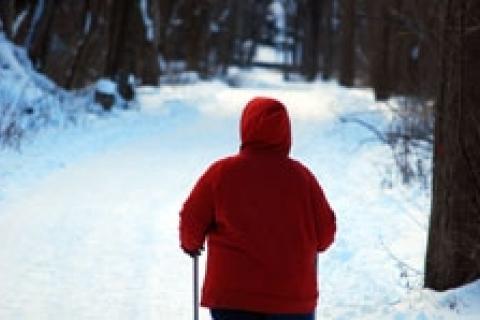
 Cold, snowy weather drives some hikers into their homes to stoke the fires until spring. That's unfortunate, as winter hiking reveals the natural world in a beautiful state well worth the effort to experience. Most fair-weather hikers I've talked with consider winter hiking too risky or uncomfortable. With a slight adjustment to the gear list and wardrobe, a day on the trail in winter mode is great fun.
Cold, snowy weather drives some hikers into their homes to stoke the fires until spring. That's unfortunate, as winter hiking reveals the natural world in a beautiful state well worth the effort to experience. Most fair-weather hikers I've talked with consider winter hiking too risky or uncomfortable. With a slight adjustment to the gear list and wardrobe, a day on the trail in winter mode is great fun.
A winter hike should be started early in the day as possible, so more time can be spent hiking on a daylight shortened day. Dress in layers is the key for keeping your body at a comfortable temperature. As the hike progresses the peeling of layers can keep a heated body from over sweating. Be sure to throw a layer back on during a snack and water break to keep the chills away.
When the autumn hiking season ends, empty your daypack of gear and reevaluate what will and not be needed on a winter excursion. Be sure to include a butane lighter, small candle (for light and heat), a headlamp, emergency blanket and hand and toe warming packets. I also like to add a half of a backpacking, foam sleeping pad (cut one in half and share a half with a hiking companion), which keeps your rear end warm and dry during sit down breaks.
Sturdy hiking boots are a must to keep ankles secure while maneuvering over frozen ground, crossing creek rocks and ascending and descending snowy trails. Strap on a pair of removable cleats if ice covers any portion of your planned trail. Removable cleats add minimal weight to your feet, but cleats do reduce leg muscle stress by providing confident footing. Grip two, or at least one, extendable hiking staff even if the trail is dry and stable. A sturdy hiking staff makes a great brake going downhill and also a lift going up.
Have a sensible plan in place before winter trekking. Consider the temps and how quick they will drop in the afternoon. If the trail is snow covered or muddy, allow additional time for navigating the terrain. Give a friend or family member a call and let them know of your plans and approximate return time — just in case. Above all, cinch up the boot strings and just get out there. There's a lot to see and do before the wildflowers burst up through the spring soil.
Five keys to safe winter hiking:
- Layer clothing: add or reduce as needed
- Warm gear: hand warmer packets, emergency blankets
- Boots: add removable traction cleats
- Hiking staff: adjustable trekking pole to stable balance
- Plan: inform family or friend of your hike and share map
- 3543 views

